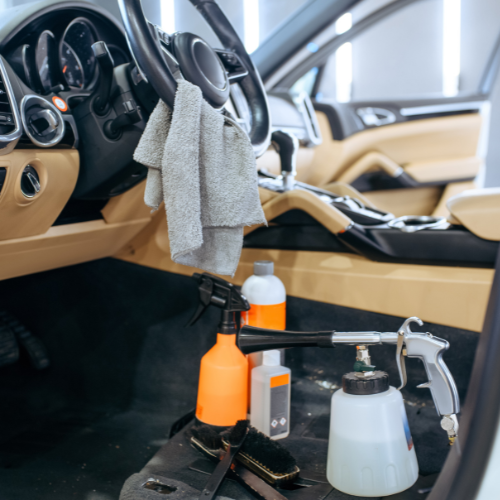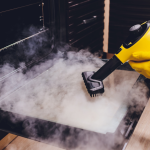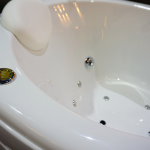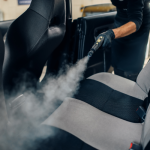No matter the type of insect infesting your car—be it ants, spiders, cockroaches, beetles, or other unsettling critters—it’s crucial to devise a strategy for their removal! Spotting an occasional bug isn’t cause for alarm. However, stumbling upon a swarm can indeed be frightening! We empathize with your distress, but there’s no need to resort to drastic measures like demolishing your car or purchasing a new one. There are effective preventive measures that can exterminate these pests and maintain your vehicle as a bug-free zone. Often, you can tackle this problem on your own, without needing to enlist an extermination expert.
Why Do Bugs and Cockroaches Inhabit Your Car?
The reason is simple: insects gravitate towards human habitats, which explains their presence in both homes and vehicles. Cockroaches seek shelter, sustenance, and water; finding these in your car turns it into their ideal abode.
What Types of Bugs and Cockroaches Might You Encounter in Your Car?
You’re likely to come across:
- Cockroaches
- Ants
- Spiders
- Bed bugs
- Beetles
Typically, these pests or pets appear individually, like a solitary spider. However, a spider needs food, which means other insects might be nearby. Insects attract other insects, particularly if the spider is on the hunt. The variety of bugs in your car is influenced by several factors such as the season, weather, and temperature—some seek refuge from the cold, while others look for a cooler environment. Regardless of the climate, cockroaches pose a constant threat if they discover food, water, and shelter in your vehicle.
How Do Cockroaches Gain Entry to Your Vehicle?
Bugs and roaches employ various methods to infiltrate your car:
Open windows: An obvious entry point, open windows not only invite thieves but insects too. In essence, insects are opportunistic invaders.
- Tip: If your vehicle is parked for extended periods, keep the windows shut to prevent easy access for cockroaches.
- Clothing and personal belongings: Encountering cockroaches likely means transporting them via your luggage or clothing directly into your car. Insects are adept at concealing themselves within groceries, garments, and everyday objects, regardless of whether they’re purchased or borrowed. Tragically, these pests can lay eggs in these items, transforming a couple of bugs into a full-blown infestation.
- Vehicle’s small openings: Cracks, door gaps, and structural damages in the vehicle serve as an open invitation to these pests.
Leaving windows open can lead to severe infestations. A clean garage or parking area might save you from unwanted visitors. However, parking in a dirty, cluttered space increases the risk of an insect invasion. Choose wisely between fresh air and unintentionally hosting a mini zoo.
Locating Bugs and Cockroaches in Your Vehicle
To eradicate these pests, you must first find their hiding spots. Look for areas that offer safety and food, as cockroaches thrive under ideal living conditions. Your car is riddled with such hideouts. Inspect:
- Interior spaces, particularly beneath the seats, on carpets, and where the seatback meets the seat—spots where food and debris accumulate, serving as prime real estate for bugs.
- Dark and warm areas, including door interiors, beneath carpets, between floor mats and floors, the center console, glove compartments, speakers, and even the ventilation system are potential insect hideaways.
- Car door panels, often repositories for food packaging, provide both sustenance and shelter for insects.
Carpets are especially vulnerable as they collect dust and crumbs, offering a conducive environment for bugs to nest, destroy fibers, and reproduce, potentially leading to a burgeoning colony within your vehicle.
The Crucial Need to Eliminate Insects and Cockroaches from Your Vehicle
While many insects are harmless, certain species can cause significant damage to your vehicle and pose health risks to you and your passengers. Carpet beetles, bed bugs, and especially cockroaches pose the greatest threat as they not only damage your car but can also impact your health by leaving behind bodily fluids and feces teeming with bacteria. The best course of action for both your health and your vehicle’s longevity is to eradicate these pests.
How to Efficiently Remove Bugs and Cockroaches from Your Vehicle: A Detailed Six-Step Guide
You’re likely eager to tackle this problem quickly, but remember, precision is more critical than speed in this endeavor. It’s essential to meticulously follow a six-step process to ensure every unwanted guest, such as cockroaches or carpet beetles, is thoroughly removed.
Thorough Inspection of the Vehicle Interior
- Begin with a detailed examination of your car’s interior. Look for live and dead insects, including cockroaches and other bugs, as well as their eggs, larvae, and even their secretions, which might resemble coffee grounds and be easy to overlook. Pay close attention to all potential hiding spots for these pests.
Deep Cleaning Your Vehicle
- Next, clean your car thoroughly, removing any potential food sources for the bugs like scraps of paper, food wrappers, crumbs, hair, and other organic materials. Also, remove items such as carpets and blankets that provide ideal hiding places for these insects. Cleaning your car manually to eliminate as much debris as possible will simplify subsequent steps.
Vacuuming Your Car
- Vacuuming is a crucial part of cleaning your vehicle. It helps eliminate particles that are not visible to the naked eye and cannot be removed manually. Vacuum every nook and cranny meticulously, focusing on seats and the floor area beneath them, to reach even the most concealed spots. Removing as much organic matter and debris as possible during this stage makes the following steps more straightforward.
Selecting an Appropriate Vacuum
- It’s advisable to research and choose a vacuum cleaner that is highly recommended for car detailing and washing, ensuring it is effective for this specific cleaning challenge.
Executing the Extermination
- Now comes the pivotal and most awaited step: exterminating the pests. While many opt for chemical sprays or insecticidal bombs, consider using more natural and less harmful solutions to kill the cockroaches and their larvae. Combining such treatments with steam cleaning ensures a comprehensive and successful eradication of these pests from your vehicle.
Why Resorting to a Bug Bomb Might Not Be Ideal
Using sprays and bombs to combat insects might not be the best approach due to their high toxicity and flammability. These aerosol-based solutions have limited effectiveness and pose a risk of discoloring upholstery or leaving unsightly marks. Additionally, it’s challenging to reach every hidden corner with spray, potentially driving the pests into more secluded areas, thereby undermining your cleaning efforts. While steam cleaning can mitigate some chemical residues, it’s impossible to eliminate them completely.
Should you find yourself with no alternative but to use a chemical spray, opt for a period when the car can be left to ventilate for several days to avoid direct exposure. Bear in mind the potential for damage to upholstery and ensure thorough cleansing of the air conditioning system to prevent inhaling harmful substances.
Healthier and More Effective Biological Control Methods
Gel baits are effective in luring and eliminating cockroaches by attracting them to consume the bait placed in strategic locations, such as under seats or in the trunk. Notably, these baits are safe for both children and pets, offering a solution that targets pests without posing significant risk to humans or animals. Cockroaches that ingest the gel bait will perish, and those that return to their colony can spread the bait further, enhancing its effectiveness.
Boric acid represents another efficient method for eradicating cockroaches, safe for contact with children and pets. Mixing it with attractive food scraps can effectively lure and kill pests. Simply deploying boric acid in areas frequented by insects can yield significant results.
In more severe infestations, employing an Insect Growth Regulator (IGR) combined with bait can accelerate the eradication process, targeting the cockroach population within a single generation.
Detailing Your Vehicle with a Commercial Steam Cleaner
Following manual cleaning and vacuuming, and after addressing the bug issue with bait or insecticides, employing a steam cleaner can significantly improve the cleanliness of your car’s interior. This step is crucial, especially if chemical treatments were used, to eliminate residual bugs, bacteria, and unwanted dirt. Adding vinegar to the steam cleaner or using a cedar extract spray can enhance effectiveness against specific pests like carpet beetles.
Thorough washing and possibly professional detailing are recommended to ensure the complete removal of pests. Don’t overlook the vehicle’s exterior, as maintaining cleanliness can deter future infestations.
Eliminating Odors with an Ozone Generator
Despite thorough cleaning, unpleasant odors from bugs can linger in hard-to-reach places. An ozone generator can be a valuable tool in neutralizing these odors and sanitizing the vehicle post-cleanup.
Maintaining a Bug-Free Vehicle
To prevent the return of pests, regular cleaning and maintenance of your vehicle are essential. Avoid eating inside the car when possible, promptly address spills, and avoid storing food to discourage insect attraction. Regular vacuuming, especially under mats and in difficult-to-reach areas, along with decluttering, can significantly reduce the risk of infestation. Regular washing, both DIY and professional, along with careful parking choices, can further safeguard your vehicle. Utilizing natural deterrents and considering professional fumigation if necessary can also contribute to keeping your car pest-free.
To keep your car free from cockroaches and bugs, adopting a proactive and consistent approach is crucial. Here are some further detailed tips to ensure your vehicle remains a no-go zone for pests:
- Consistent Cleanliness: The importance of keeping your car clean cannot be overstated. Regular washing and interior cleaning play a pivotal role in deterring pests. Remember, a clean car is less inviting to insects looking for food and shelter.
- Mindful Eating: While it’s best to avoid eating in your car, if you must, be diligent about not leaving crumbs or food particles behind. Vacuum the interior regularly to remove any traces of food that could attract insects.
- Immediate Spill Response: Spills should be cleaned immediately. Liquids, especially sugary ones, can attract a wide range of insects. Swiftly wiping up spills can prevent this issue before it starts.
- Avoid Storing Food: Keeping food in your car, even for short periods, can attract bugs. If you must transport food, ensure it’s well-sealed and removed from the car as soon as possible.
- Regular Vacuuming: Vacuum your car thoroughly every few weeks, paying special attention to under mats and hard-to-reach areas where bugs might hide.
- Declutter: A cluttered car offers more hiding spots for pests. Keeping your car tidy and free of unnecessary items can reduce the likelihood of an infestation.
- Exterior Maintenance: The condition of your car’s exterior can also affect its attractiveness to pests. Regularly washing your car, including professional washes, can remove residues that attract bugs.
- Strategic Parking: Be cautious about where you park your car. Avoid areas under trees where pests are more prevalent. After parking in such areas, check your car for any bugs that might have hitched a ride.
- Keep Windows Closed: Leaving windows open, even slightly, can invite insects inside. Keep windows closed, especially when parked in areas known for high insect activity.
- Natural Repellents: Employ natural deterrents within your car, such as garlic, bay leaves, or catnip. These can discourage pests without the use of harmful chemicals.
- Home Remedies: For immediate action against a visible bug, a simple solution of water and dishwashing detergent can be effective. Spraying this mixture on pests can kill them without resorting to toxic chemicals.
- Professional Fumigation: If all else fails and your vehicle is severely infested, professional fumigation may be necessary. This should be considered a last resort due to the chemicals involved but can be effective in completely eradicating pests from your car.
By implementing these measures, you can significantly reduce the risk of pest infestations in your vehicle, protecting both its condition and the health of its occupants. Regular maintenance, both inside and out, coupled with prompt action against potential infestations, will keep your car pleasant and pest-free.




